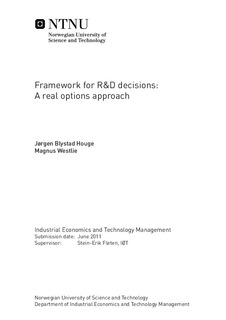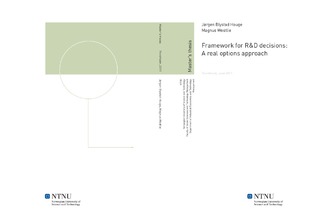| dc.description.abstract | This thesis proposes the use of the hybrid real options framework presented by Neely (1998)to facilitate valuation of, and decision making in, R&D projects. The framework combines thefavorable benefits from Decision Analysis (DA) and financial option theory, which are the twomost commonly applied methodologies for real option assessments. The combined frameworkaddresses the DA s incapability for handling a fluctuating discount rate in a practical way, andthe financial option theory s requirement of historical data, that is generally unavailable forunique R&D projects. The value of flexibility is estimated by distinguishing two types of risks;project and market risks, where DA and option theory are applied, respectively.The hybrid real options is a practical and at the same time accurate approach. It allows the useof the risk-free rate as a consistent constant discount rate. In addition, the valuation becomesorganized in the sense that the process is divided in a technical and financial part. Hence, technicaland financial experts can apply their knowledge independently. However, the framework suse of a decision tree restricts the complexity of the model as it could turn too comprehensiveto be applicable in an assessments context.When exemplifying the framework, an option to continue or abandon further development of CCSis modelled. The framework values the CCS project - at best - when continuing the development.This returns an expected profit of NOK 28 billion. However, risk analysis yields a probabilityclose to 50% that the project returns a loss of similar magnitude. The estimated expected valueis NOK 860 million higher compared to the traditional Net Present Value methodology. Hence,the value of including the inherent flexibility of an R&D project is significant. In this context,this difference represents the option value in the decision of whether to implement or not.The sensitivity analysis concludes that the annual growth in production stand out as the mostimportant variable for the expected value of Carbon Capture and Storage (CCS). This is ratherintuitive as new production yields possibly large emissions of CO2, which is the main benefitdriver for the CCS technology. In addition, the share of unconventional oil in new production,that we assume would require CCS, is essential.We extend the framework of Neely (1998) by incorporating simple game theory, which provedto introduce a significant value change because of the possible strategic advantages of a CCSinvolvement. The game considered only a valuation of the First Mover Advantage (FMA) and showed that the strategic value is superior to the flexibility value by more than NOK 50 billion. The dominant strategy is to continue further development of CCS, which then values the project at NOK 48.1 billion. Now, risk analysis concludes that there is a probability of more than 70% to achieve a positive return from the CCS R&D project.For further work, a more detailed consideration of game theory is suggested. An interestingtopic would be Statoil s impact on its own technology supply environment - does it really makea difference that Statoil is engaged in the CCS field, or should it let others do the hard work? Inaddition, inclusion of other uses of the CCS technology would yield a more complete valuation. | nb_NO |

